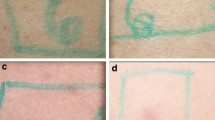Abstract
Neurofibromatosis type 1 (NF-1) is an autosomal dominant disorder characterized by skin tumours derived from peripheral nerves. It is a clinically diagnosed disorder of a mainly cosmetic concern. There are different excision modalities for treatment of cutaneous neurofibromas; however, none is considered to be universally accepted treatment. This study was conducted to evaluate a non-excision treatment of multiple cutaneous neurofibromas, using surface and interstitial approaches of neodymium:yttrium aluminum garnet (Nd:YAG) laser (1,064 nm) photocoagulation, depending upon the size and location of the lesions. Twelve patients with multiple cutaneous neurofibromas were included. Surface laser photocoagulation by long-pulsed Nd:YAG laser has been used for treatment of flat lesions, while interstitial laser photocoagulation by continuous wave (CW) Nd:YAG laser has been used for treatment of bulkier lesions. After 14 months of follow up, both approaches of laser photocoagulation have shown different success rates, as denoted by the regression of the lesions, an overall acceptable cosmetic outcome, and, generally, patients’ satisfaction. Within the limitations of the present study, laser photocoagulation has proven to be a promising technique that may be an alternative or additive modality for treatment of multiple cutaneous neurofibromas. It is a minimally invasive, office-based technique that could be used safely and effectively, with a limited rate of complications. Surface laser photocoagulation has proven to be an effective tool for treatment of flat lesions, especially those located in exposed areas, with a favourable cosmetic result, while interstitial laser photocoagulation could be reserved for bulkier lesions, especially those located in non-exposed areas. However, further studies are necessary to refine the procedure, and to confirm the present encouraging findings, especially over a longer period of follow up, as well as to evaluate laser parameters for optimization of the technique.



Similar content being viewed by others
References
Needle MN, Cnaan A, Dattilo J (1997) Prognostic signs in the surgical management of plexiform neurofibroma: the Children’s Hospital of Philadelphia experience 1974–1994. J Pediatr 131:678–682
Riccardi VM (1992) Neurofibomatosis: phenotype, natural history, and pathogenesis, 2nd edn. Johns Hopkins University Press, Baltimore
Yohay KH (2006) The genetic and molecular pathogenesis of NF 1 and NF 2. Semin Pediatr Neurol 13(1):21–26
Gottfried ON, Viskochil DH, Fults DW, Couldwell WT (2006) Molecular, genetic, and cellular pathogenesis of neurofibromas and surgical implications. Neurosurgery 58(1):1–16
Acosta MT, Gioia GA, Silva AJ (2006) Neurofibomatosis type 1: new insights into neurocognitive issues. Curr Neurol Neurosci Rep 6(2):136–143
Katalinic D (1992) Laser surgery of neurofibromatosis 1 (NF 1). J Clin Laser Med Surg 10(3):185–192
Roenigk RK, Ratz JL (1987) CO2 laser treatment of cutaneous neurofibromas. J Dermatol Surg Oncol 13(2):187–190
Becker DW Jr (1991) Use of the carbon dioxide laser in treating multiple cutaneous neurofibromas. Ann Plast Surg 26(6):582–586
Algermissen B, Müller U, Katalinic D, Berlien HP (2001) CO2 laser treatment of neurofibromas of patients with neurofibromatosis type 1: five years experience. Med Laser Appl 16:265–274
Ostertag JU, Theunissen CCW, Neumann HAM (2002) Hypertrophic scars after therapy with CO2 laser for treatment of multiple cutaneous neurofibromas. Dermatol Surg 28:296–298
Algermissen B, Philipp CM, Müller U, Urban P, Berlien HP (2001) Interstitial thermotherapy (ITT) using Nd:YAG laser as a new option for the treatment of neuroma. Med Laser Appl 16:129–134
Bronstein IN, Semendjajew KA (1964) Taschenbuch Der Mathematic Verlag Harri Deutsch, 4 Auflage, Frankfurt/M. und Zürich, p 150
Raulin C, Greve B, Hammes S (2000) Cold air in laser therapy: first experiences with a new cooling system. Lasers Surg Med 27(5):404–410
Døssing H, Bennedbæk FN, Hegedüs L (2005) Effect of ultrasound-guided interstitial laser photocoagulation on benign solitary solid cold thyroid nodules—a randomized study. Eur J Endocrinol 152:341–345
Boon RTP, Fan ST, Tsang FHF, Wong J (2002) Locoregional therapies for hepatocellular carcinoma: a critical review from the surgeon’s perspective. Ann Surg 235(4):466–486
Lippert BM, Teymoortash A, Folz BJ, Werner JA (2003) Coagulation and temperature distribution in Nd:YAG interstitial laser thermotherapy: an in vitro animal study. Lasers Med Sci 18:19–24
Author information
Authors and Affiliations
Corresponding author
Rights and permissions
About this article
Cite this article
Elwakil, T.F., Samy, N.A. & Elbasiouny, M.S. Non-excision treatment of multiple cutaneous neurofibromas by laser photocoagulation. Lasers Med Sci 23, 301–306 (2008). https://doi.org/10.1007/s10103-007-0485-3
Received:
Accepted:
Published:
Issue Date:
DOI: https://doi.org/10.1007/s10103-007-0485-3




